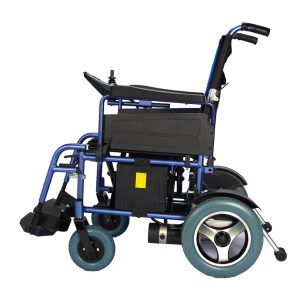Electric wheelchairs have revolutionized mobility for many, providing independence and convenience. However, the plethora of choices available in the market can be overwhelming. This comprehensive guide aims to demystify the process and help you find the electric wheelchair that best fits your individual needs and preferences.
1. Assessing Your Needs
1.1 Physical Requirements
- Weight Capacity: Consider the user’s weight and the wheelchair’s maximum weight capacity.
- Seat Dimensions: Assess the seating width, depth, and backrest height that suit your body size.
- Adjustable Features: Look for adjustable armrests, footrests, and seating angles for a personalized fit.
1.2 Lifestyle Considerations
- Indoor vs. Outdoor Use: Determine where you primarily plan to use the wheelchair.
- Travel Considerations: If you travel frequently, consider a foldable and lightweight model.
- For example Model:EW100

1.3 Medical Needs
- Support and Comfort: Consider additional support like reclining features for specific medical conditions.
- Accessibility Requirements: Ensure the model accommodates any specific accessibility needs, such as transfers or standing assistance.
- For example Model: EW8722

2. Understanding the Types
2.1 Rear-Wheel Drive
- Pros: Greater stability and easier straight-line navigation.
- Cons: Less maneuverable in tight spaces.
2.2 Front-Wheel Drive
- Pros: Increased maneuverability.
- Cons: May be less stable at higher speeds.
2.3 Mid-Wheel Drive
- Pros: Best turning radius.
- Cons: Stability can be an issue on uneven terrains.
3. Battery Life and Charging
- Battery Types: Lead-acid, Lithium-ion, etc. Each type has different longevity and charging requirements.
- Range: Consider how far you’ll travel on a typical day and choose a model with sufficient range.
- Charging Convenience: Look for models that offer quick charging and easily accessible charging ports.
4. Control Systems
- Joystick Controls: Standard control mechanism that is easy to use.
- Alternative Controls: Options for individuals with limited dexterity, such as head control or sip-and-puff systems.
5. Additional Features
- Suspension Systems: For a smooth ride on various terrains.
- Safety Features: Include anti-tip wheels, seat belts, and brake systems.
- Smart Technology: Integration with mobile apps for tracking and customizations.
6. Budget and Warranty
- Budget Considerations: Determine your budget and look for models that offer the best value.
- Warranty and Service: Look for comprehensive warranties and accessible service centers.
Conclusion
Choosing the right electric wheelchair requires thoughtful consideration of physical, lifestyle, and medical needs, along with understanding the various features and types available. Consultation with healthcare providers and mobility experts is advisable to ensure the best choice. By following this guide, you’ll be well-equipped to select an electric wheelchair that truly suits you, enhancing your independence, comfort, and quality of life.

Leave A Comment